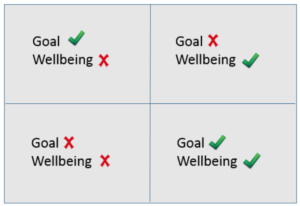The beginning of the new year is a return to business as usual for many of us. A return to busy work and home environments. With stress and burnout on the rise, it is important to consider if we are paying enough attention to our wellbeing as we step into 2017. By wellbeing, I am referring to both our mental and physical health and the overall sense of contentment in our lives.
I was reflecting on this for myself over the Christmas period and devised a simple exercise to help surface what I am doing with my time with particular focus on how this impacts my goals and my wellbeing. The exercise is easiest if you select one goal, perhaps the thing that you are focused on that is most important to you.
Goal-wellbeing Matrix
Start by making a list of the major activities (work, commuting, social media etc.) that occupy your time. The idea is to then map out these activities, paying careful attention to the impact each activity is having on (i) your chosen goal (ii) your wellbeing. The matrix below is one way of carrying out such a mapping. It is designed to uncover both alignment and divergences between goals and wellbeing.

Goal-wellbeing Matrix
The top left quadrant for example would contain all actions that you believe to be furthering your goal, but are having a negative impact on your wellbeing.
What this matrix allows us to do very quickly is to identify areas where our actions have conflicting effects. It could even surface things that you do, perhaps out of habit, that neither further your goals nor support your wellbeing (bottom-left quadrant) — clearly an area for investigation!
This simple tool can also be adapted to look at potential misalignments in other areas with greater specificity. For example, replacing ‘wellbeing’ in the matrix with another goal will allow you to evaluate tensions between two chosen goals.
Not Ignoring Misalignment
If it turns out that a significant amount of your time is spent on actions that harm your wellbeing, this begs a fundamental question — why? If our most important and treasured goals are at odds with our mental and physical health, are they really worth it?
Also consider the origins of these goals. When were they formed? Why were they chosen? What makes them so important that we are willing to overlook our wellbeing?
Inevitably, the impact of certain activities will be complex and difficult to label as either being positive or negative. An identification of this is in itself useful information as it allows us the opportunity to look closer — to go beyond the surface presentation of matters.
Final Thoughts
We will all have unique circumstance in our lives that have shaped our goals and actions in the past. We have to remember though that wherever we stand, we always have a choice about how we proceed. Wishing all of you joy and contentment in 2017!


Recent Comments